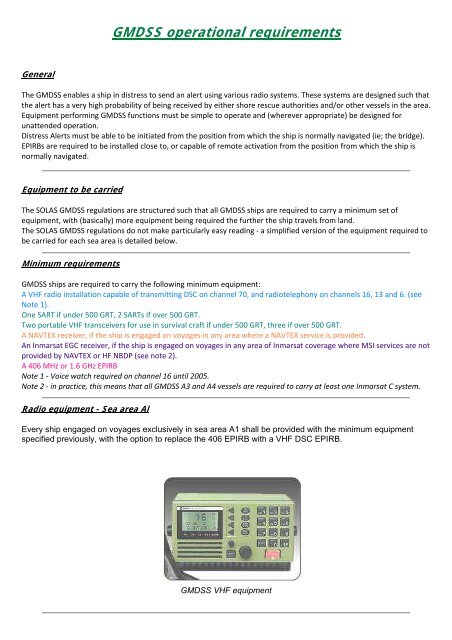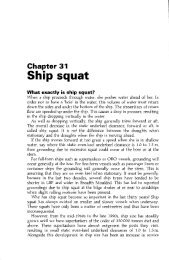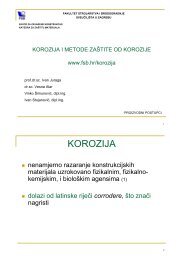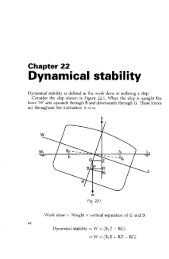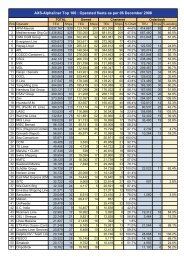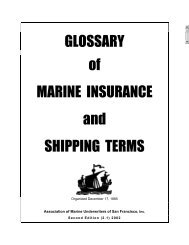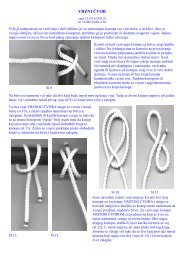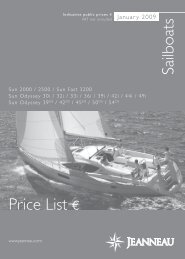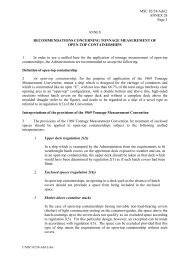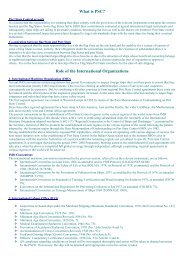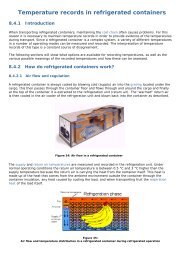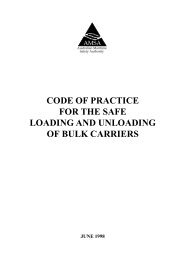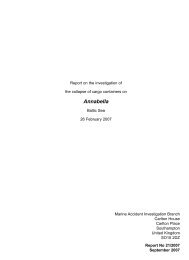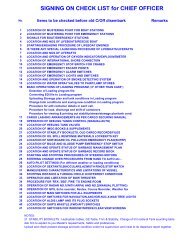GMDSS operational requirements
GMDSS operational requirements
GMDSS operational requirements
You also want an ePaper? Increase the reach of your titles
YUMPU automatically turns print PDFs into web optimized ePapers that Google loves.
<strong>GMDSS</strong> <strong>operational</strong> <strong>requirements</strong>GeneralThe <strong>GMDSS</strong> enables a ship in distress to send an alert using various radio systems. These systems are designed such thatthe alert has a very high probability of being received by either shore rescue authorities and/or other vessels in the area.Equipment performing <strong>GMDSS</strong> functions must be simple to operate and (wherever appropriate) be designed forunattended operation.Distress Alerts must be able to be initiated from the position from which the ship is normally navigated (ie; the bridge).EPIRBs are required to be installed close to, or capable of remote activation from the position from which the ship isnormally navigated.Equipment to be carriedThe SOLAS <strong>GMDSS</strong> regulations are structured such that all <strong>GMDSS</strong> ships are required to carry a minimum set ofequipment, with (basically) more equipment being required the further the ship travels from land.The SOLAS <strong>GMDSS</strong> regulations do not make particularly easy reading ‐ a simplified version of the equipment required tobe carried for each sea area is detailed below.Minimum <strong>requirements</strong><strong>GMDSS</strong> ships are required to carry the following minimum equipment:A VHF radio installation capable of transmitting DSC on channel 70, and radiotelephony on channels 16, 13 and 6. (seeNote 1).One SART if under 500 GRT, 2 SARTs if over 500 GRT.Two portable VHF transceivers for use in survival craft if under 500 GRT, three if over 500 GRT.A NAVTEX receiver, if the ship is engaged on voyages in any area where a NAVTEX service is provided.An Inmarsat EGC receiver, if the ship is engaged on voyages in any area of Inmarsat coverage where MSI services are notprovided by NAVTEX or HF NBDP (see note 2).A 406 MHz or 1.6 GHz EPIRBNote 1 ‐ Voice watch required on channel 16 until 2005.Note 2 ‐ in practice, this means that all <strong>GMDSS</strong> A3 and A4 vessels are required to carry at least one Inmarsat C system.Radio equipment - Sea area AlEvery ship engaged on voyages exclusively in sea area A1 shall be provided with the minimum equipmentspecified previously, with the option to replace the 406 EPIRB with a VHF DSC EPIRB.<strong>GMDSS</strong> VHF equipment
Radio equipment - Sea areas A1 and A2Every ship engaged on voyages beyond sea area A1, but remaining within sea area A2, shall be providedwith the minimum equipment specified previously, plus:• An MF radio installation capable of transmitting and receiving on the frequencies2187.5 kHz using DSC and 2182 kHz using radiotelephony;• a DSC watchkeeping receiver operating on 2187.5 kHz• A 406 MHz EPIRBTypical <strong>GMDSS</strong> A2 stationThe ship shall, in addition, be capable of transmitting and receiving general radiocommunications usingradiotelephony or direct-printing telegraphy by:• A HF radio installation operating on working frequencies in the (marine) bandsbetween 1,605 kHz and 27,500 kHz. (This requirement is normally fulfilled by theaddition of this capability in the MF equipment referred to earlier).Radio equipment - Sea areas A1, A2 and A3These vessels have two options to satisfy their <strong>GMDSS</strong> <strong>requirements</strong>. The options allow a vessel to choosefrom the primary method to be used for ship-shore alerting ;Every ship engaged on voyages beyond sea areas A1 and A2, but remaining within sea area A3 shall beprovided with the minimum equipment specified previously, plus either:OR• An Inmarsat C ship earth station :• An MF radio installation and 2187.5 kHz DSC watchkeeping receiver;• A 406 MHz EPIRB• An MF/HF radio installation capable of transmitting and receiving on all distress andsafety frequencies in the (marine) bands between 1,605 kHz and 27,500 kHz: usingDSC, radiotelephony; and NBDP• An MF/HF DSC watchkeeping receiver capable of maintaining DSC watch on 2,187.5kHz, 8,414.5 kHz and on at least one of the distress and safety DSC frequencies4,207.5 kHz, 6,312 kHz, 12,577 kHz or 16,804.5 kHz; at any time, it shall be possible toselect any of these DSC distress and safety frequencies• A 406 MHz EPIRB• An Inmarsat ship earth station
Typical <strong>GMDSS</strong> A3 stationIn addition, ships shall be capable of transmitting and receiving general radiocommunications usingradiotelephony or direct-printing telegraphy by an MF/HF radio installation operating on working frequencies inthe (marine) bands between 1,605 kHz and 27,500 kHz. This requirement is normally fulfilled by the addition ofthis capability in the MF/HF equipment referred to earlier.In practice, MF only transceivers are not produced - all marine MF radio equipment is also fitted with HFfacilities.Radio equipment - Sea areas Al, A2, A3 and A4In addition to carrying the equipment listed previously, every ship engaged on voyages in all sea areasshall be provided with:• An MF/HF radio installation as described earlier• An MF/HF DSC watchkeeping receiver as described earlier• A 406 MHz EPIRBIn addition, ships shall be capable of transmitting and receiving general radiocommunications usingradiotelephony or direct-printing telegraphy by an MF/HF radio installation as described earlier.Means of ensuring availability of ship station equipmentRegulation 15 of the SOLAS <strong>GMDSS</strong> regulations defines 3 methods to ensure availability of <strong>GMDSS</strong>equipment at sea;• At sea electronic maintenance, requiring the carriage of a qualified radio/electronicofficer (holding a <strong>GMDSS</strong> First or Second class Radio-Electronics Certificate) andadequate spares and manuals;• Duplication of certain equipment; or• Shore based maintenanceShips engaged on voyages in sea areas A1 and A2 are required to use at least one of the three maintenancemethods outlined above, or a combination as may be approved by their administration. Ships engaged onvoyages in sea areas A3 and A4 are required to use at least two of the methods outlined above.And of course what all that means is that 99% of A3 <strong>GMDSS</strong> ships, along with probably 100% of A1 and A2<strong>GMDSS</strong> ships do not opt for at sea maintenance - they either duplicate the equipment and use shore basedmaintenance (for A3 ships), or use shore based maintenance only (A1 and A2 ships).
Equipment to be duplicated for area A3 vessels<strong>GMDSS</strong> ships operating in A3 areas are required to provide the following duplicated equipment;• Two complete VHF installations (including DSC), and either;• Two complete Inmarsat C systems and one MF radio system, or;• One complete Inmarsat C system and one complete MF/HF radio system (including ascanning DSC receiver and NBDP equipment).Many <strong>GMDSS</strong> ships opt for the latter option (1 Inmarsat C and one MF/HF DSC system), on cost grounds.Unfortunately, this has proven to be one of the underlying causes of the present extremely high false alertingrate on some <strong>GMDSS</strong> systems.Power supply <strong>requirements</strong><strong>GMDSS</strong> equipment is required to be powered from three sources of supply:• ship's normal alternators/generators;• ship's emergency alternator/generator (if fitted); and• a dedicated radio battery supply.The batteries are required to have a capacity to power the equipment for 1 hour on ships with an emergencygenerator, and 6 hours on ships not fitted with an emergency generator.The batteries must be charged by an automatic charger, which is also required to be powered from the mainand emergency generators.Changeover from AC to battery supply must be automatic, and effected in such a way that any any data heldby the equipment is not corrupted (ie: "no break").Operator qualificationsThere are a number of different types of <strong>GMDSS</strong> qualifications, as follows:• First Class Radio-Electronic Certificate;• Second Class Radio-Electronic Certificate; and• <strong>GMDSS</strong> General Operator's CertificateThe First and Second Radio-Electronic Certificates are diploma and associate diploma level technicalqualifications. They are designed for Ship's Radio-Electronic Officers, who sail on <strong>GMDSS</strong> ships which use theoption of at-sea electronic maintenance.The <strong>GMDSS</strong> General Operator's Certificate is a non-technical operator qualification, designed for NavigatingOfficers.The <strong>GMDSS</strong> General Operator's Certificate is normally awarded after a ten day course and examination.


